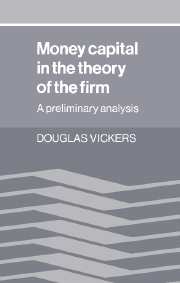2 - Assets, capital, and capitalization
Published online by Cambridge University Press: 18 September 2009
Summary
The conceptual foundations and technical apparatus of the theory of the firm require an understanding of the financial statements that describe the firm's economic position and structure. These are its periodic balance sheet and income statement. The examination of these documents establishes a linkage between the theory of the firm and an important dichotomy employed in many parts of economic analysis. This is the distinction between stock variables and stock analysis on the one hand and flow variables and flow analysis on the other.
On this important matter, the theory of the firm has been ambivalent. Following the recrudescence of interest in the firm's optimization problems in the 1930s, the distinguished economist Kenneth Boulding could still say, in the first edition of his A Reconstruction of Economics in 1950, that “the concept of the balance sheet, unfortunately, has not been employed to any extent in developing the static theory of the firm, so that as generally presented in the textbooks the firm is a strange bloodless creature without a balance sheet, without any visible capital structure, without debts, and engaged apparently in the simultaneous purchase of inputs and sale of outputs at constant rates” (1950, p. 34. See also Boulding, 1966, Vol. I, p. 305). Brian Loasby is probably not too wide of the mark when he comments on “the widespread contempt exhibited by economists for accounting (the more scandalous for not being recognized as a scandal)” (1971, p. 882).
- Type
- Chapter
- Information
- Money Capital in the Theory of the FirmA Preliminary Analysis, pp. 22 - 40Publisher: Cambridge University PressPrint publication year: 1987



